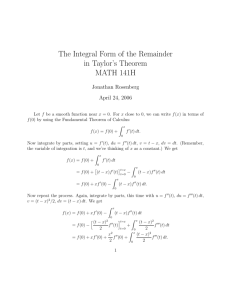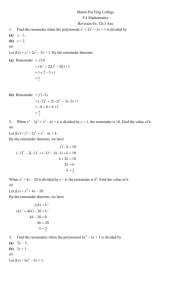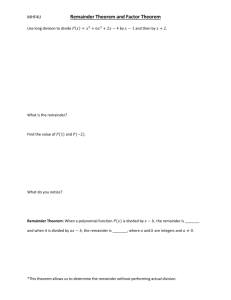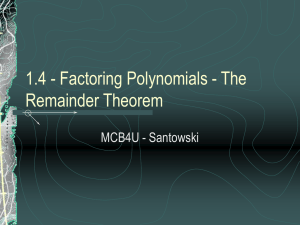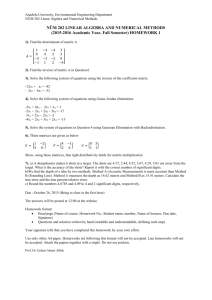Section 3.3 Dividing Polynomials
advertisement
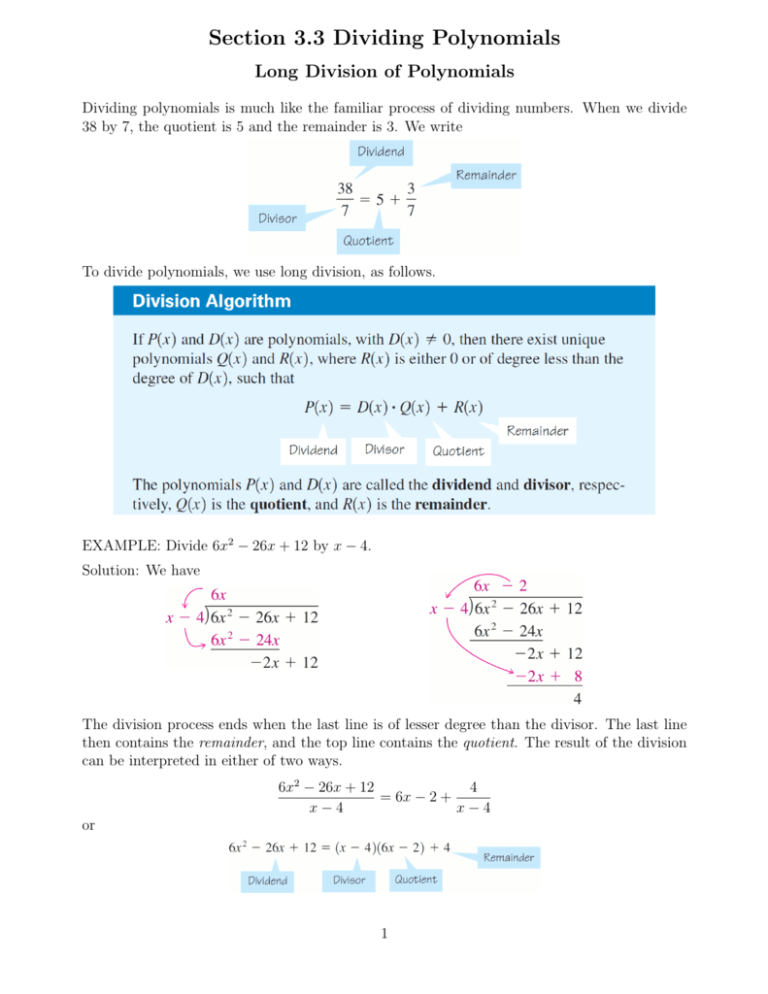
Section 3.3 Dividing Polynomials Long Division of Polynomials Dividing polynomials is much like the familiar process of dividing numbers. When we divide 38 by 7, the quotient is 5 and the remainder is 3. We write To divide polynomials, we use long division, as follows. EXAMPLE: Divide 6x2 − 26x + 12 by x − 4. Solution: We have The division process ends when the last line is of lesser degree than the divisor. The last line then contains the remainder, and the top line contains the quotient. The result of the division can be interpreted in either of two ways. 4 6x2 − 26x + 12 = 6x − 2 + x−4 x−4 or 1 EXAMPLE: Let P (x) = 8x4 + 6x2 − 3x + 1 and D(x) = 2x2 − x + 2. Find polynomials Q(x) and R(x) such that P (x) = D(x) · Q(x) + R(x). Solution: We have 4x2 + 2x 2x2 − x + 2 8x4 + 6x2 − 3x + 1 4 3 − 8x + 4x − 8x2 4x3 − 2x2 − 3x − 4x3 + 2x2 − 4x − 7x + 1 The process is complete at this point because −7x + 1 is of lesser degree than the divisor 2x2 − x + 2. From the above long division we see that Q(x) = 4x2 + 2x and R(x) = −7x + 1, so 8x4 + 6x2 − 3x + 1 = (2x2 − x + 2)(4x2 + 2x) + (−7x + 1) EXAMPLE: Divide x3 + 2x2 − 3x + 1 by x2 + 1. Solution: We have x+2 x +1 x + 2x − 3x + 1 − x3 −x 2 2x − 4x + 1 − 2x2 −2 − 4x − 1 2 3 2 So x3 + 2x2 − 3x + 1 = (x2 + 1)(x + 2) + (−4x − 1). EXAMPLE: Divide 2x3 − 7x2 + 5 by x − 3. Solution: We have So 2x3 − 7x2 + 5 = (x − 3)(2x2 − x − 3) + (−4). 2 The Remainder and Factor Theorems The next theorem shows how synthetic division can be used to evaluate polynomials easily. Proof: If the divisor in the Division Algorithm is of the form x − c for some real number c, then the remainder must be a constant (since the degree of the remainder is less than the degree of the divisor). If we call this constant r, then P (x) = (x − c) · Q(x) + r =⇒ P (c) = (c − c) · Q(c) + r = 0 + r = r that is, P (c) is the remainder r. EXAMPLE: Let P (x) = 3x5 + 5x4 − 4x3 + 7x + 3. (a) Find the quotient and remainder when P (x) is divided by x + 2. (b) Use the Remainder Theorem to find P (−2). Solution: (a) We have 3 3x4 − x3 − 2x2 + 4x − 1 x+2 3x5 + 5x4 − 4x3 + 7x + 3 5 4 − 3x − 6x − x4 − 4x3 x4 + 2x3 − 2x3 2x3 + 4x2 4x2 + 7x − 4x2 − 8x −x+3 x+2 5 or −2 3 5 −4 0 7 3 −6 2 4 −8 2 −1 −2 4 −1 5 The quotient is 3x4 − x3 − 2x2 + 4x − 1, and the remainder is 5. (b) By the Remainder Theorem, P (−2) is the remainder when P (x) is divided by x − (−2) = x + 2. From part (a) the remainder is 5, so P (−2) = 5. EXAMPLE: Let P (x) = 8x5 − 2x4 + 10x3 + x2 − 20x + 10. (a) Find the quotient and remainder when P (x) is divided by x + 2. (b) Use the Remainder Theorem to find P (−2). 3 EXAMPLE: Let P (x) = 8x5 − 2x4 + 10x3 + x2 − 20x + 10. (a) Find the quotient and remainder when P (x) is divided by x + 2. (b) Use the Remainder Theorem to find P (−2). Solution: (a) We have 8x4 − 18x3 + 46x2 − 91x + 162 x+2 8x5 − 2x4 + 10x3 + x2 − 20x + 10 − 8x5 − 16x4 − 18x4 + 10x3 18x4 + 36x3 46x3 + x2 − 46x3 − 92x2 − 91x2 − 20x 91x2 + 182x 162x + 10 − 162x − 324 − 314 or 8 −2 8 −2 10 1 − 20 10 − 16 36 − 92 182 − 324 − 18 46 − 91 162 − 314 The quotient is 8x4 − 18x3 + 46x2 − 91x + 162, and the remainder is −314. (b) By the Remainder Theorem, P (−2) is the remainder when P (x) is divided by x − (−2) = x + 2. From part (a) the remainder is 5, so P (−2) = −314. EXAMPLE: Let P (x) = x3 − 7x + 6. Show that P (1) = 0, and use this fact to factor P (x) completely. Solution: Substituting, we see that P (1) = 13 − 7 · 1 + 6 = 0. By the Factor Theorem, this means that x − 1 is a factor of P (x). Using long or synthetic division x2 + x − 6 or 1 0 −7 6 3 x−1 x − 7x + 6 1 1 1 −6 − x3 + x2 1 1 −6 0 x2 − 7x − x2 + x − 6x + 6 6x − 6 0 therefore P (x) = x3 − 7x + 6 = (x − 1)(x2 + x − 6) = (x − 1)(x − 2)(x + 3). 4 EXAMPLE: Let P (x) = x3 + x2 − 94x + 176. Factor P (x) completely. Solution: One can see that P (2) = 23 + 22 − 94 · 2 + 176 = 0. By the Factor Theorem, this means that x − 2 is a factor of P (x). Using long or synthetic division 1 x2 + 3x − 88 x−2 x3 + x2 − 94x + 176 − x3 + 2x2 3x2 − 94x − 3x2 + 6x − 88x + 176 88x − 176 0 2 or 1 1 − 94 176 2 6 − 176 3 − 88 0 therefore P (x) = x3 + x2 − 94x + 176 = (x − 2)(x2 + 3x − 88) = (x − 2)(x − 8)(x + 11) EXAMPLE: Let P (x) = x3 + 21x2 − 157x + 135. Factor P (x) completely. Solution: One can see that P (1) = 13 + 21 · 12 − 157 · 1 + 135 = 0. By the Factor Theorem, this means that x − 1 is a factor of P (x). Using long or synthetic division 1 x2 + 22x − 135 x−1 x3 + 21x2 − 157x + 135 − x3 + x2 22x2 − 157x − 22x2 + 22x − 135x + 135 135x − 135 0 1 or 1 therefore P (x) = x3 + 21x2 − 157x + 135 = (x − 1)(x2 + 22x − 135) = (x − 1)(x − 5)(x + 27) 5 21 − 157 135 1 22 − 135 22 − 135 0 EXAMPLE: Find a polynomial of degree 4 that has zeros −3, 0, 1, and 5. Solution: By the Factor Theorem, x − (−3), x − 0, x − 1, and x − 5 must all be factors of the desired polynomial, so let P (x) = (x + 3)(x − 0)(x − 1)(x − 5) = x4 − 3x3 − 13x2 + 15x Since P (x) is of degree 4 it is a solution of the problem. Any other solution of the problem must be a constant multiple of P (x), since only multiplication by a constant does not change the degree. The polynomial P is graphed in the Figure below. Note that the zeros of P correspond to the x-intercepts of the graph. 6 Appendix EXAMPLE: Divide x2 − 2x + 1 by x − 1. Solution: We have 1 x−1 x−1 x − 2x + 1 − x2 + x −x+1 x−1 0 −2 1 1 −1 −1 0 1 or 2 1 So x2 − 2x + 1 = (x − 1)(x − 1) + 0 = (x − 1)2 . EXAMPLE: Divide 8x3 − 3x2 + 2x − 1 by x + 2. Solution: We have 8 2 8x − 19x + 40 x+2 8x3 − 3x2 + 2x − 1 − 8x3 − 16x2 − 19x2 + 2x 19x2 + 38x 40x − 1 − 40x − 80 − 81 or −2 8 −3 2 −1 − 16 38 − 80 − 19 40 − 81 So 8x3 − 3x2 + 2x − 1 = (x + 2)(8x2 − 19x + 40) + (−81). EXAMPLE: Divide x5 + 1 by 2x3 + x + 1. Solution: We have 1 2 x 2 2x3 + x + 1 x5 − x5 − 12 x3 − 12 x2 − 21 x3 − 12 x2 +1 1 3 1 1 x + x + 2 4 4 − 21 x2 + 14 x + 45 So 5 3 − 14 +1 x + 1 = (2x + x + 1) 1 2 1 x − 2 4 7 1 1 5 + − x2 + x + 2 4 4

